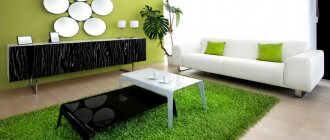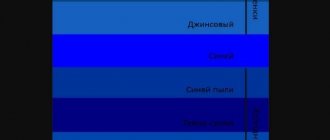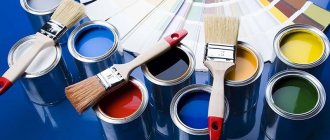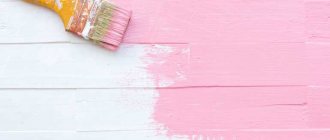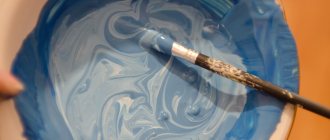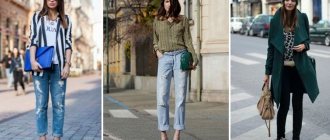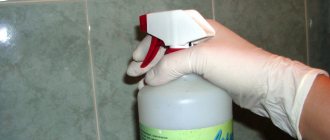How to get turquoise color
In this article we will look at ways to create turquoise color by mixing paints.
Turquoise color is very attractive, harmonious and relaxing. This color has a very good effect on a person and calms him down. Turquoise, also called aquamarine, falls somewhere between green and blue on the color wheel. It ranges from soft, light tones to richer, deeper ones.
If you need a given color, in one shade or another, but you can’t find and purchase ready-made paint, don’t be discouraged by some manipulations of mixing colors, you will achieve the desired result.
Mixing Food Coloring: Color Chart and Basic Rules
Food coloring will make your culinary creations bright, original and memorable. To decorate your dishes in all the colors of the rainbow, you don’t have to purchase the entire palette of food colors. It is enough to buy the main colors and get the rest of the shades by mixing.
The main colors are red, blue, yellow, white and black. With these paints in stock, you can get almost any shade.
How to make light turquoise and soft turquoise from paints and gouache when mixed?
The color turquoise is quite popular and in demand today, but its various shades and tones are no less popular. Let's see what we need to get these shades of turquoise.
Before you start mixing paints, you need to prepare the following materials:
- A board on which we will mix paints
- Brush
- White paint
- blue paint
- Green paint
We get turquoise color
When everything you need is already at hand, you can begin the process itself:
- To get the light shade of turquoise we need, take green and blue paint, you can also take a little yellow. Please note that these should be pure shades that are most similar to the standard colors of the spectrum
- Place a certain part of the blue color on a special board and add green in small parts using a brush; if the desired color does not work out, add a drop of yellow paint. Also, to obtain a light turquoise hue, add a little white to the prepared mixture until you see the desired result on the palette
If you need a delicate shade of turquoise for your work, you need to do the following manipulations:
- Take green, blue, white and gray paints
- Apply a certain amount of blue color to a special board
- Mix green and white paint colors separately. Add white in small portions and gradually until you obtain a light green or, as it is called, a pastel green hue.
- Add the resulting pastel green shade to the blue color until you see a soft, creamy, soft turquoise shade
- For an even more delicate, muted shade, you can add a touch of gray paint.
How to make colored cream for a cake from natural dyes
When it comes to decorating homemade baked goods, especially a cake, a lot of questions arise about how to do it beautifully, what techniques should be used, what part of the confectionery product should be decorated. It is worth taking into account fashion trends, which are currently characterized by minimalism in the design of any dishes. This means that when decorating cakes you should feel free to experiment with creams. It is worth not only combining unique tastes, but also colors. To paint a product with rainbow colors, you need to know one secret: how to make colored cream for a cake using food and natural dyes.
How to get a sea green color when mixing paints or gouache?
This color definitely resembles the color of the sea. This color is absolutely appropriate and popular both in creativity and in the wardrobe. So, to get the desired color we need to prepare:
- Green paint
- blue paint
- Sponge
- Brush
- A board on which we will mix paints
Creating an aqua color
Next we follow these instructions:
- Take the 2 paint colors above that are closest to the standard colors on the spectrum and place them side by side on the palette
- Mix the paints until a homogeneous consistency is formed.
- From the added amount of blue, aqua color can vary from soft, faded, lightish tones to richer, deeper and more intense dark green shades
- To get a delicate, pastel shade of sea green, you will need to add a bit of white paint.
We recommend taking a closer look
White liquid food coloring “Luxomix” Titanium dioxide 0062 (0.2 kg)
Liquid food coloring "Luxomix" Sugar color III (E150c) (0.2 kg)
Strawberry-red liquid food coloring “Luxomix” Carmine 0038 (0.2 kg)
Color mixing: table
The process of obtaining one color or another is, in principle, always the same. You need to take all the colors you need, arm yourself with a brush and palette, and then, gradually mixing the paints, achieve the desired color and shade. But immediately remembering which colors need to be mixed to get the desired result is not always so easy. Therefore, we present to your attention a table that will definitely help you quickly cope with this process.
As you can see, getting such a beautiful turquoise color and its different shades is not so difficult. To achieve the desired result, you just need to arm yourself with paints of suitable colors, a brush, a palette, and, of course, add a little imagination to all this.
Turquoise color can be easily obtained by mixing paints. By definition, turquoise is a shade of blue and green, a sea green color, close to cyan. There are a number of ways to achieve turquoise, they will depend on the result the artist wants.
Precautions when using synthetic dyes
Naturally, a synthetic dye has many advantages over the natural version, since the colors are very bright and there is no need to bother with obtaining the component.
Many housewives know exactly how to make colored cake cream at home using synthetic dye, but not many know how to use such a product correctly.
Before purchasing, you need to carefully read the instructions and the composition of the dye, discarding those options where there are some unclear points or inscriptions. When adding a coloring agent to the cream, you must strictly follow the proportions specified in the instructions.
Before mixing the cream with the dye, the first component must be completely cooled. You cannot store a confectionery product that uses a synthetic component to color the cream for more than 1 day.
Turquoise color in nature, its meaning
Turquoise is one of the most beautiful shades; it is widespread in the world around us. This tone can be seen on the sea near resort shores; the water in the area of sea lagoons, various oases and water quarries is colored turquoise. Different shades of turquoise are seen in the sky in the early hours of the morning. This color is not present in the main palette; it must be obtained by combining paints.
Psychologists call turquoise cold and mysterious, although people associate it with intimate conversations with friends. In the countries of the East, the color symbolizes faith, healing, compassion, and in Europe it was previously considered a talisman that bestows good luck.
Alternative medicine uses turquoise in color therapy: this shade is good for the eyes, can strengthen the immune system, and reduces the risk of overload, depression and stress. It is believed that this tone is very harmonious, designed to add calmness and balance to a person, and helps control emotions.
Getting a turquoise shade
Making turquoise with your own hands is not difficult. To do this, you can use gouache, watercolor, acrylic paints, you just need to mix them in certain proportions. Since turquoise is a mixture of green with a drop of blue, these two basic tones will be required to prepare the paint.
There are no clear instructions on the number of colors. Search is a creative process where paint standards are selected individually. To work you need:
- white palette or plate;
- tassels;
- a glass of water;
- paper.
You should take a sufficient amount of greenery for work, which does not have foreign impurities, and then add blue drop by drop. The colors should be mixed after introducing each new portion of the material. In any case, the amount of blue paint should be less than green. If a color seems right, you should try it out. To do this, make a smear on the paper - a uniform turquoise tone should remain on it.
There are various shades of turquoise - sea wave, azure, blue-green, as well as curacao, aquamarine, the color of thrush eggs and others, which are exotic to the ears of beginners. It is worth considering the process of making the most popular turquoise halftones in more detail.
Light turquoise
To create a lighter tone, you will need blue paint rather than blue. It is made using the simplest method - adding a little white to the desired degree of lightening. Then they begin to gradually introduce a blue tone into the green until a delicate turquoise tint begins to “emerge.” Also, professionals often add a drop of yellow paint to the mixture - it adds brightness and lightness to the greenery, making it light green, so the finished turquoise will be airy and very beautiful. If the finished tone does not seem delicate enough, it can be diluted with any amount of white paint until a pastel shade is obtained.
Getting turquoise color by mixing paints
In the color palette, turquoise is located in the middle - between green and blue. The shade is not fixed in a single standard form. It has countless variations: from calm pastel colors to catchy saturated colors. It is not always possible to find the required jar of new paint, so the only possible solution is to get the note yourself by mixing two basic tones. How to get turquoise color when mixing paints?
How to choose paints
The famous color of Tiffany jewelry boxes, in most cases, involves mixing in unequal proportions of green (the majority) with blue (the smaller part). The perfect flower combination has not been invented to create turquoise when mixing paints, so a variety of shades can be achieved.
A delicate pastel tone is obtained as a result of small splashes of gray and white. A mixture of blue, green and yellow acquires a deep and rich coating.
In the video: the basics of mixing colors.
Coloring cream cheese using any type of dye
In order not to think for a long time about how to make colored cream cheese for a cake, you should initially take butter instead of cream, which will have a yellow color. The product will be pastel yellow or ivory or champagne.
To add brighter colors to the cheese, you should use food or natural dyes. The simplest option is to mix the product with cocoa or chocolate. You need to add the required amount of dye to the mass and mix everything using a silicone spatula.
Basis
The principle of obtaining the desired color is clear; it is worth considering other ways to achieve it. Any green and blue base is acceptable: water, oil, acrylic, gouache.
There is a minor nuance in the artistic scheme: it is advisable to mix paints of the same type.
It is advisable to buy materials in specialized stores; it is quite possible to find the expected tone in finished form among a wide assortment.
Watercolor
Emerald, yellow and blue are taken in small drops in order to maintain maximum accuracy. For beginner artists, it is preferable to choose watercolors. It is flexible and easy to handle. Most often, watercolors can be found on sale in tubes. Yellow paint works well with pale tones.
To get a muted turquoise color, you should add a little white to the tandem of blue and green. The use of warm cream is suitable for an artistic depiction of the depths of the sea washing the Cote d'Azur.
I wonder what solutions should be used to implement a space theme on canvas. It would be more appropriate to take a whiter cream color as a basis and use a green blue dye (it is permissible to use variations of ultramarine, azure or cobalt).
All pigments are impregnated with a small proportion of other colors, which is convenient when combining paint of any shade with any other.
How and how to color cream without using dyes
There are several ways to color the cream without using any types of dyes - just add a colored product. Everyone knows perfectly well that the first and simplest ingredient for coloring is chocolate and cocoa.
The instructions on how to make colored cream for a cake without dyes are quite simple. Clean the coloring product as much as possible from large particles and fibers. And then add to the cream. Cleaning is important because, in addition to chocolate and cocoa, jam can be used for coloring, for example.
In addition to these methods of coloring without dyes, you can use additional colored ingredients to prepare the cream: zest, berries and many other options.
Source
Rich shade
In the process of mixing two basic tones, you can resort to the ideal solution: make blue paint with green pigment.
There is no standard pure foundation. For example, it is believed that blue in tandem with yellow acquires a green color, and with red - purple. In reality, the edges are blurred: the main color tends to green or red due to the imperfect chemical transparency of each individual pigment.
To get a turquoise color, and the deepest one, you need to use the indicated blue and green.
- Apply a drop of cyan paint (blue-green) to the edge of the palette.
- Near the cyan one, place a little green. If green paint is not available, you should prepare it yourself: mix yellow and blue in equal proportions on any clean and always dry surface.
- To get the color, you need to mix blue and emerald in a 2:1 ratio. Deviations in the ratios are possible, but for the first experimental time it is desirable to maintain the specified balance. By adding green, the shade will deviate towards the sea green color, reducing its amount - blue will appear more noticeable in turquoise.
Shades of turquoise
As with any complementary color, there are many variations of turquoise. It all depends on the imagination of the master. Conventionally, the following colors can be distinguished:
Light colors: light turquoise, sky turquoise, blue turquoise. Here, as you might guess, a large amount of white predominates. Therefore, to create a pale turquoise tone, add more white color. It is worth noting that flesh can be used as an additional color. The result will be a soft shade of sea wave foam.
Medium: classic shade, bright turquoise, cyan. The latter is close to blue, so only 10% green is enough to get it.
Dark: dark turquoise, thrush eggs, very dark turquoise. To get a dark shade, use blue as the starting color. Add green to it. White – intervenes at the end of the process if necessary. Shades such as very dark turquoise and thrush eggs contain a bit of black, which gives them a grayish appearance. It must be added very carefully at the end of mixing the paints.
Greenish: turquoise pearl, aquamarine, Tiffany. These shades resemble sea green due to the high concentration of green in the composition. The previously mentioned Tiffany tone is obtained by mixing 2 parts blue and 1 part green.
Color proportions for obtaining basic shades of turquoise
To understand exactly what shade of turquoise you will get with certain proportions of paints, at first you can refer to the table below. Over time, you will find shades that will meet exactly your criteria. Experiment and everything will work out!
| Resulting shades | Initial colors and their ratio |
| Light turquoise | blue 100% + green 10-15% + white 2% |
| Delicate turquoise | blue 100% + green 10% + cream 5% |
| Dark turquoise | cyan 100% + green 30% |
| Tiffany | blue 100% + green 50% |
| Sea wave | green 100% + blue 50% + white 10% |
| Cyanogen | blue 100% + green 10% |
Turquoise color in nature, its meaning
Turquoise is one of the most beautiful shades; it is widespread in the world around us. This tone can be seen on the sea near resort shores; the water in the area of sea lagoons, various oases and water quarries is colored turquoise. Different shades of turquoise are seen in the sky in the early hours of the morning. This color is not present in the main palette; it must be obtained by combining paints.
Psychologists call turquoise cold and mysterious, although people associate it with intimate conversations with friends. In the countries of the East, the color symbolizes faith, healing, compassion, and in Europe it was previously considered a talisman that bestows good luck.
Alternative medicine uses turquoise in color therapy: this shade is good for the eyes, can strengthen the immune system, and reduces the risk of overload, depression and stress. It is believed that this tone is very harmonious, designed to add calmness and balance to a person, and helps control emotions.
Getting a turquoise shade
Making turquoise with your own hands is not difficult. To do this, you can use gouache, watercolor, acrylic paints, you just need to mix them in certain proportions. Since turquoise is a mixture of green with a drop of blue, these two basic tones will be required to prepare the paint.
There are no clear instructions on the number of colors. Search is a creative process where paint standards are selected individually. To work you need:
- white palette or plate;
- tassels;
- a glass of water;
- paper.
You should take a sufficient amount of greenery for work, which does not have foreign impurities, and then add blue drop by drop. The colors should be mixed after introducing each new portion of the material. In any case, the amount of blue paint should be less than green. If a color seems right, you should try it out. To do this, make a smear on the paper - a uniform turquoise tone should remain on it.
There are various shades of turquoise - sea wave, azure, blue-green, as well as curacao, aquamarine, the color of thrush eggs and others, which are exotic to the ears of beginners. It is worth considering the process of making the most popular turquoise halftones in more detail.
Light turquoise
To create a lighter tone, you will need blue paint rather than blue. It is made using the simplest method - adding a little white to the desired degree of lightening. Then they begin to gradually introduce a blue tone into the green until a delicate turquoise tint begins to “emerge.” Also, professionals often add a drop of yellow paint to the mixture - it adds brightness and lightness to the greenery, making it light green, so the finished turquoise will be airy and very beautiful. If the finished tone does not seem delicate enough, it can be diluted with any amount of white paint until a pastel shade is obtained.
When light turquoise still needs to be “cooled,” you can add a little gray paint to the finished color scheme. That is, they mix green, blue, white and gray tones. The result is an unusual muted color, perfect for painting pictures of the sky.
Dark turquoise
Making dark tones of turquoise yourself is also easy. To do this, you should purchase cyan paint, which already has a green tint with a hint of blue (sold in an artist store). You need to put a little of this paint on the palette, then add the usual green color in small portions. The dark turquoise color is achieved by adding a small amount of greens, and thorough mixing is very important. Some specialists add a little brown to darken the tone even more; this color will be a little warmer than ordinary turquoise.
Aquamarine
Sea color is obtained in a similar way. It will require two standard colors - blue and green - in approximately equal proportions. They are mixed until smooth, then a tiny amount of white paint is added for some lightening. Depending on the amount of white, the sea green color will change from rich to paler. Professionals call marine color a mixture of blue phthalocyanine and titanium dioxide, but for the average person, ordinary (classic) gouache from a store is quite suitable.
Methods for obtaining the desired tone
So, what colors should you mix? If we talk about pure color, it is obtained by combining 2 pigments: titanium dioxide and phthalocyanine blue (cyan blue). The name of the paint components of a particular manufacturer can be found on the Internet or on the packaging. But in practice there are other ways to make turquoise. Let's consider two options for making the desired tone.
The principle of obtaining turquoise for paints is the same, regardless of whether it is gouache, watercolor, oil or acrylic paints. The main thing is to mix paints of the same composition.
Mix blue and green
So, to get turquoise color you need to take blue and green colors. The main tone, as mentioned earlier, is blue. Therefore, a second one is gradually added to it until the desired result, but no more than 20%, otherwise the desired one will turn into a sea green color.
Additionally, depending on the required shade, the following colors can be added to the turquoise color scheme: white, yellow, gray, black.
If blue is not available, then the desired color is obtained by mixing 3 colors: blue, white and green.
Depending on the type of paint and manufacturer, the name of the shades may vary. For example, when working with gouache, you can mix azure, white and bright green as the initial paints. If you work with ultramarine, then you will need less green to get a beautiful shade.

